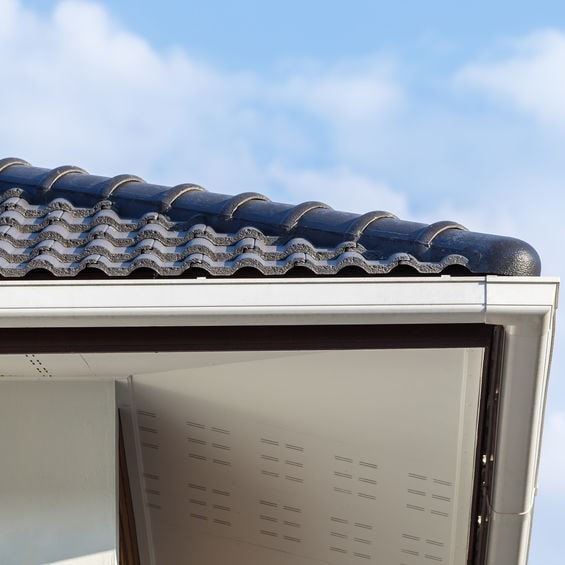Protecting your roof from water damage
If your home came with gutters, congratulations. If your home didn’t and you’re considering gutter installation but aren’t sure they are important enough for the expense, keep reading. That is exactly what we’re going to discuss today: The importance of a gutter installation.
A common question for DIY homeowners is, “Can I install gutters myself?” and the answer is yes. If you have the tools and the time, by all means, do your own gutter installation. We recommend view several YouTube videos, if the home improvement store near you is offering a Saturday morning class, sign up. Because if you don’t follow gutter installation instructions right, you’re going to have leaking gutters.
What can you do with your gutter installation to make sure they don’t leak? Here are a few of the common reasons why gutters leak, cause if they’re leaking, they aren’t doing their job:
Improperly Sloped
A gentle slope with your gutter installation is needed if your gutters are going to work right. Water runs downhill from the rooftop to the gutters. The slight downward slope keeps the water in the gutters, running toward the downspout.
- It is important to get that slope right with the gutter installation, so they don’t start sagging. Gutters without a slight slope will begin filling up with debris, the water will pool up inside the gutter runs, never making it to the downspouts.
- Three things can happen: 1). The gutter get heavy, sag, bend, and break. 2). The gutters get corroded, rusted, and rot through. 3). The rain has nowhere to go but up under the shingles, soak the decking and felt, get into your attic, and costly damage begins. Once you have completed your gutter installation, double check the slope and adjust.
Now, with that stated about a DIY gutter installation and preventing gutter leaks, two additional things you’ll need to watch for from time to time. Along with DIY gutter installation and repairs will include check your gutter connections and slopes.
Loose Gutters
- Make a monthly inspection of your gutters, or after significant weather activity. If you notice they seem to be loose and falling off or pulling away, you probably have what appears to be a leak. Chances are they probably aren’t fastened on to the fascia as tight as they should be, now water is coming behind the gutter run from the roof edge.
- The first step to take is check the fascia board. If it has begun rotting, you’ll need to replace it before you reattach the gutters installation. A gutter run isn’t going to stay fastened to rotted fascia board. Once you have replaced any rotted fascia board, re attached your gutter installation with new fasteners.
Aging Gutters
- If your gutter installation is new and recent, this won’t be a concern for 10-12 years. However, if you home had gutters when you purchase it, you’ll need to check them frequently for signs of aging. Remember, water flows the path with the least resistance, and if your gutter connections have become undone, or a corroded, rusted area has created a hole, you may be able to repair them with a waterproof sealant. Or it may be time for a new gutter installation.
Clogged Gutters
- There are two sides to having gutter guards, but one thing they are good about doing is preventing gutter clogs. If your gutters seem to get clogged up and overflow frequently, you may want to consider gutter guard installation. Another thing to help with keeping gutters unclogged is keeping trees trimmed back from the roof.
How do you attach gutters?
This is the part of your DIY gutter installation where the slope we mentioned earlier must be done precisely or you’ll have leaking gutters. First, you’ll need to attach the fascia brackets:
- Using chalk, mark a line at each rafter tail behind the fascia, typically 16 inches apart.
- Create a pilot hole of ⅛-inch-diameter through the fascia, into the rafter tail at those marked lines.
- Use quarter-inch stainless steel lag screws to fasten the fascia brackets.
- Using a hacksaw, cut gutter sections to proper length and if cutting corner pieces, cut a 45-degree angle.
- Where a gutter run has two sections coming together, make an eight inch overlap then attach two rows of self-tapping, stainless steel screws to join them.
- With aluminum pop rivets, connect a spherical cap on the square-cut ends.
- Apply a layer of silicone caulk along the seam to ensure the run is watertight.
- Place the gutter runs in the brackets you connected to the fascia.
- Make sure back edge of the gutter is in the hooks at the top.
- Using a drill, insert a one inch stainless steel screw (#8-32) through the screw-mounting hole on every bracket to secure the gutter run in place.
Do you install gutters under drip edge?
Yes, your gutter installation with drip edge should be mounted on the front of the fascia, so that the gutter run that is sloping towards the downspout is below the drip-edge flashing. The the roofing shingles should be three-fourth of an inch extended past the drip edge’s top flange.
Why does water leak behind my gutters?
We listed reasons why a gutter installation may have water leaking, but water leaking from the backside of the gutter is typically because the gutter apron wasn’t done properly or there wasn’t any flashing installed over the gutter’s backside.
This is typically called the gutter apron, a bent piece of flashing that is tucked up under the shingles then folded over the gutter. If you’re doing your own gutter installation, you can purchase gutter apron ready to install in 10 foot sections.
How do you seal a gutter joint?
A common problem with gutter installation, as they age, or go through weather events, they sometimes begin to leak at the joints and seams. This is an simple fix for the handy DIY homeowner, especially if you have mastered your own gutter installation, with these steps:
- Remove any old bolts and nuts
- Separate the gutter runs
- Remove all debris from the gutter runs
- Clean the ends, joints, and seams
- Apply metal primer
- Make sure the joint that needs repair is thoroughly dry,
- With an applicator gun, apply roof-and-gutter sealant to the joints and seams that are leaking and spread generously
- Replace new bolts and nuts
That is totally understandable, especially if you work all week, you don’t want to spend your weekend doing things like gutter installation. Plus, if you have it professionally done, you’ll have a warranty if there are any problems later. So, do roofers install gutters?
Yes, most roofing companies have a division that does nothing but gutter installation. Or they will contract with a third party gutter company to do the gutter installation.
There are gutter installation companies and that is all they do is gutter installation. While a roofer can install gutters, a gutter installation company isn’t experienced at installing a new roof. Call (817) 677-6664 today for gutter installation in Arlington, TX.



